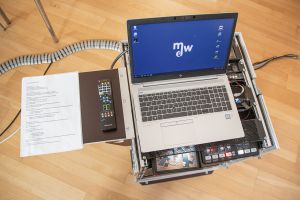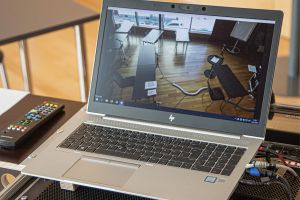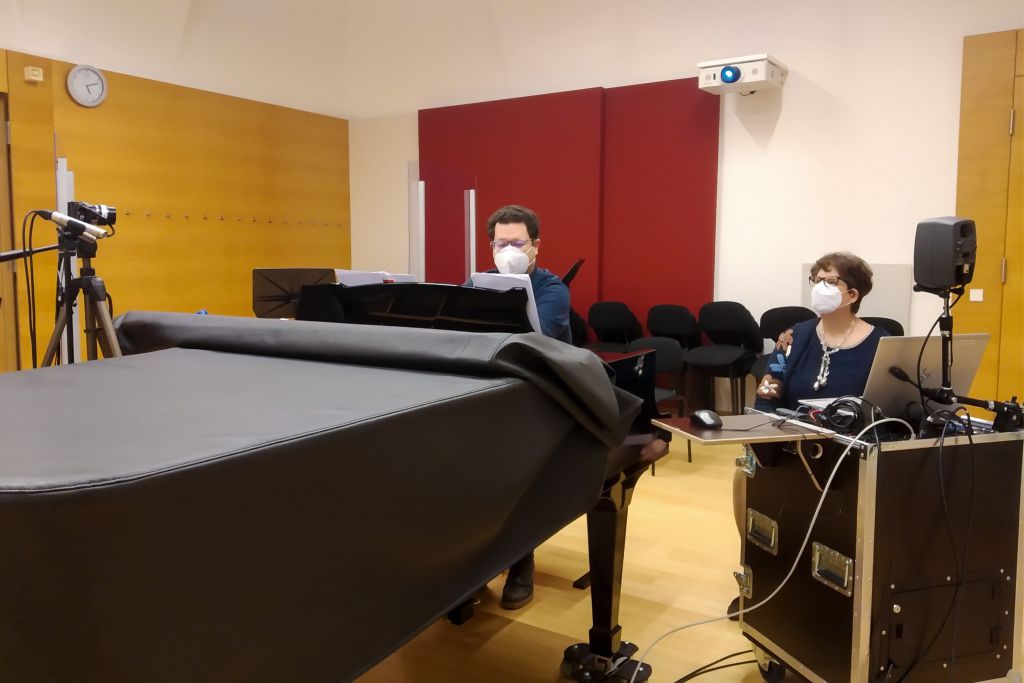Online professorship search committee hearings, digital entrance exams, blended learning—the worldwide COVID-19 pandemic has catalysed the digitisation process in education. And at the mdw, the Audio/Video Centre—part of the University’s Information Technology Department (ZID)—has been a strong institution-wide partner in these trying times.

“Music and performing arts universities make different demands of real-time digital transmission than do other institutions, where it’s mainly about language and PowerPoint presentations,” says Tonmeister Florian Rabl of the AV Centre team when asked about the challenges of digital instruction at the mdw. “Widely used solutions like Zoom, Webex, and Skype were initially focused on the transmission of language and visual material, so we were forced to develop complementary systems in order to meet the more stringent requirements for streaming music at our arts university.” In their work to improve options for real-time transmission, the AV Centre team was able to build on the University’s pre-existing server and network infrastructure, the requisite AV equipment, and the relevant know-how of Tonmeister Ulrich Wagner and his colleagues.
You can focus the camera on specific areas, pressing record and then playing it back. That isn’t possible in conventional on-site teaching.
Thomas Lang, head of the mdw’s Audio/Video Centre
The quality of training at the mdw is based quite centrally on individual attention from instructors, professional-level practical experience, and direct, face-to-face interaction, all of which make extreme demands on real-time multimedia transmission methods. “At the moment, it’s hardly possible to do high-quality real-time transmission in any other context than between universities via the fast broadband connections of the Austrian Academic Computer Network (ACOnet) and systems like LoLa (Low-Latency Audio-Video Streaming System),” says AV Centre head Thomas Lang in order to temper any exaggerated expectations. “As a rule, the high transmission quality needed for musical evaluation depends on users’ own technical infrastructure. So we’ve attempted to optimise things and concentrate our measures in this area.”
The main point has been to improve the situation for students using supplementary AV equipment while also protecting university faculty who belong to risk groups. “Now, since we’ve equipped lesson rooms with high-quality cameras and audio components, students have the additional option of coming to the mdw and taking individual lessons in their main artistic subjects using Zoom in High-Fidelity Music Mode,” explains Florian Rabl. “Streaming individual lessons definitely represents a compromise to suit the current situation, but it also opens up new teaching options.” Such new options may ultimately prove to be a helpful complement to in-person teaching, as well—because things like the ability to reproduce a situation not only open up new didactic approaches for teachers but also embody a self-analysis tool for students.
All of my colleagues are qualified Tonmeisters—and their comprehensive knowledge has been a great foundation upon which to build.
Florian Rabl, Audio/Video Centre
The high-quality equipment available in the lecture halls for lectures and seminars in artistic and academic subjects as well as the AV workstations developed in house by the AV team feature a high degree of usability as well as compatibility with the necessary technical systems. “You can switch between various camera angles, screen sharing mode, or between the group in the room and the online participants. What’s more, the new workstations make it possible to stream and record at the press of a button. You can then directly upload the recording to Moodle in perfectly sized portions,” says Katharina Pfennigstorf of the Department of Cultural Management and Gender Studies (IKM) on the options for hybrid teaching, which embodies a mixture of on-site and online instruction. “It’s unbelievable what the AV Centre has managed, here. And it’s been more than once that people from the outside have asked me who was responsible for developing this technology.” Her department plans to use these new tools in the future, as well: “In the Cultural Management programme, we have no desire to go back to the pre-COVID digital stone ages. What we have now just works way too well for that, and the students already value it way too much.”

The Department of Piano’s Markus Hadulla also recognises these new technologies’ potential in distance learning: “In the future, we’ll be able to do things like brief digital check-ups in order to react more spontaneously to student’s individual needs.” These and many further innovative possibilities opened up by recent technological advances are being included in the mdw’s Digitisation Strategy, which aims to harness these opportunities to the benefit of art, teaching, and research.
Even if teaching remotely can end up requiring more effort overall, I’m learning to value its strong points and can imagine combining it with other methods the future.
Marlene Lacherstorfer, Department of Music and Movement Education/Rhythmics and Music Physiology
Wilfried Aigner of the Department of Music Education Research, Music Didactics and Elementary Music Education is well aware of how digitisation has potentials but also limits: “Though we can take away quite a bit from distance learning, it doesn’t allow future schoolteachers to experience how is it to stand in front of and interact with 30 kids at once. But I do see opportunities in trying out new instructional approaches as well as in the considerable additional skill sets that everyone’s acquiring.”

The necessary know-how is provided and taught by the AV Centre team as well as in the form of extensive training provided by the Centre for Further Education (ZfW), which reacted right at the beginning of the first lockdown with offerings to help people cope with the new situation. “We’re schooling people technically, organising exchange between colleagues, and offering skill-building measures and various other services in order to help support the mdw’s teaching staff and students,” says ZfW head Dagny Schreiner.
The AV Centre is putting forth a huge effort to support us in Zooming live and integrating this option into our teaching.
Andrea Pfestorf-Janke, Anton Bruckner Department of Choral and Ensemble Directing and Music Theory in Music Education
The Information Technology Department has also ploughed considerable effort into beefing up the learning management system Moodle as well as the mdw’s system for managing examinations. “We’re currently working on making it easier to set up Moodle courses, which it will eventually be possible to do via mdwOnline,” says the Information Technology Department’s Arno Traninger. And for the contact-free conduct of entrance examinations, the ZID quickly produced a solution that will also be available for future use: the mdwBox, the mdw’s online storage system, enables applicants to upload their audition videos and examination committee members to access them. “This proved an interesting option above all for the initial rounds, because it saved the applicants a trip here.”
The smooth collaboration between the AV Centre and the ZID’s other specialised departments plus efficient communication with the University’s faculty and Rectorate are viewed by Thomas Lang as central factors in the successful implementation and constant evaluation of ongoing projects. “We’re continuing to make improvements. It’s a work in progress and also research that we’re doing here,” is how Florian Rabl describes the digitisation process—”and the knowledge we’re gleaning from this is also useful in pedagogy and didactics.” To Rabl, blended learning means not only connecting on-site and remote learning but also figuring out how to optimally interlace tools and methods. “We’ve laid the foundation, and we’re now curious to see where things will go from here on out.”


